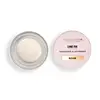What's inside
What's inside
 Key Ingredients
Key Ingredients

 Benefits
Benefits

 Concerns
Concerns

 Ingredients Side-by-side
Ingredients Side-by-side

Dimethicone
EmollientDimethicone Crosspolymer
Emulsion StabilisingOctyldodecanol
EmollientIsohexadecane
EmollientPhenyl Trimethicone
Skin ConditioningOzokerite
Emulsion StabilisingSilica
AbrasiveMica
Cosmetic ColorantSynthetic Sapphire
Ethylhexyl Palmitate
EmollientCera Microcristallina
Emulsion StabilisingVinyl Dimethicone/Methicone Silsesquioxane Crosspolymer
Helianthus Annuus Seed Oil
EmollientHydrogenated Polyisobutene
EmollientTridecyl Trimellitate
EmollientSorbitan Sesquioleate
EmulsifyingTocopherol
AntioxidantLaminaria Digitata Powder
Skin ConditioningIsocetyl Stearoyl Stearate
EmollientTribehenin
EmollientSorbeth-30 Tetraisostearate
EmulsifyingPalmitoyl Tripeptide-1
Skin ConditioningSodium Hyaluronate
HumectantGlyceryl Behenate
EmollientLimnanthes Alba Seed Oil
Skin ConditioningFullerenes
AntimicrobialSqualane
EmollientCI 77491
Cosmetic ColorantCI 77492
Cosmetic ColorantCI 77891
Cosmetic ColorantDimethicone, Dimethicone Crosspolymer, Octyldodecanol, Isohexadecane, Phenyl Trimethicone, Ozokerite, Silica, Mica, Synthetic Sapphire, Ethylhexyl Palmitate, Cera Microcristallina, Vinyl Dimethicone/Methicone Silsesquioxane Crosspolymer, Helianthus Annuus Seed Oil, Hydrogenated Polyisobutene, Tridecyl Trimellitate, Sorbitan Sesquioleate, Tocopherol, Laminaria Digitata Powder, Isocetyl Stearoyl Stearate, Tribehenin, Sorbeth-30 Tetraisostearate, Palmitoyl Tripeptide-1, Sodium Hyaluronate, Glyceryl Behenate, Limnanthes Alba Seed Oil, Fullerenes, Squalane, CI 77491, CI 77492, CI 77891
Dimethicone
EmollientDimethicone Crosspolymer
Emulsion StabilisingCera Microcristallina
Emulsion StabilisingIsononyl Isononanoate
EmollientKaolin
AbrasivePetrolatum
EmollientC30-45 Alkyl Methicone
EmollientC30-45 Olefin
Skin ConditioningPropylparaben
PreservativeBHT
AntioxidantEthylhexyl Palmitate
EmollientPolybutene
Paraffinum Liquidum
EmollientIsopropyl Myristate
EmollientBis-Diglyceryl Polyacyladipate-1
EmollientCI 77491
Cosmetic ColorantCI 77492
Cosmetic ColorantAlternatives
Ingredients Explained
These ingredients are found in both products.
Ingredients higher up in an ingredient list are typically present in a larger amount.
Cera Microcristallina isn't fungal acne safe.
Ci 77491 is also hydrated iron III oxide. It's sole purpose is to give a red/pink hue to products.
Iron III oxides are classified as inorganic chemicals for coloring.
Synthetically created Ci 77491 is considered safer than those naturally found. This is because the synthetically created version may contain less impurities. Iron oxides are generally non-toxic and non-allergenic.
Learn more about CI 77491Ci 77492 is also hydrated iron III oxide. It's sole purpose is to give a yellow hue to products.
Iron III oxides are classified as inorganic chemicals for coloring.
Synthetically created Ci 77492 is considered safer than those naturally found. This is because the synthetically created version may contain less impurities. Iron oxides are generally non-toxic and non-allergenic.
Learn more about CI 77492Dimethicone is a type of synthetic silicone created from natural materials such as quartz.
What it does:
Dimethicone comes in different viscosities:
Depending on the viscosity, dimethicone has different properties.
Ingredients lists don't always show which type is used, so we recommend reaching out to the brand if you have questions about the viscosity.
This ingredient is unlikely to cause irritation because it does not get absorbed into skin. However, people with silicone allergies should be careful about using this ingredient.
Note: Dimethicone may contribute to pilling. This is because it is not oil or water soluble, so pilling may occur when layered with products. When mixed with heavy oils in a formula, the outcome is also quite greasy.
Learn more about DimethiconeDimethicone Crosspolymer is a silicone created by modifying dimethicone with hydrocarbon side chains. Due to its large size, it does not penetrate skin. It is considered non-occlusive.
Dimethicone Crosspolymer is used to stabilize and thicken products. It also helps give products a silky feel.
Ethylhexyl Palmitate, also known as octyl palmitate, is created from 2-ethylhexyl alcohol and palmitic acid. It is a fatty acid ester.
The fatty acid content of Ethylhexyl Palmitate makes it an emollient. Emollients help soften and hydrate your skin by trapping moisture within.
Ethylhexyl Palmitate is also used to help improve the texture of cosmetics. It helps other ingredient dissolve in products and help disperse ingredients more evenly.
You'll likely find this ingredient in sunscreen, as it is often used to mix UV-blocking ingredients such as avobenzone and ethylhexyl triazone.
It can also help stabilize the fragrances in a product as a fragrance fixative.
Ethylhexyl Palmitate can be used to substitute mineral oil.
Due to its high fatty acid content, it may not be fungal-acne safe.
Learn more about Ethylhexyl Palmitate